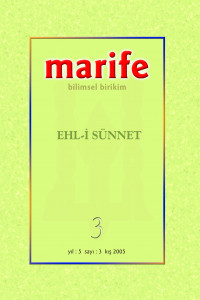Abstract
In the historical process, Ahl al-Sunna wa'l-Camaa has been established as a main
structure of religion, apart from the sects like Khavarij, Murjie, Shia, Mutazila, and their
branches. Its formation has been completed in a long period both as conceptual and a
form of thought. It is not accurate to consider this formation like other sects. Because it
has not feature of sect circulated and followed by a crtain group of people. Besides, by
leaving extreme points ruled by other sects, it is seen as an interpretation of moderate
line in Islam according to time and circumstances. Nevertheless, it is possible to mention
some religious formations which contradicted each other in ahl al-sunna wa’l-camaa. The
differences which it has contained can be seen as an evidence, proof and examples of
freedom of thought. Despite of differences in the schools of ahl al- sunna wa'l-camaa
the basic tenets of religion is one of the shared points. Because of these features it is
quite difficult to fit it into a particular frame and determine its boundaries. The scholars
belonging to this formation had not accepted the political problems as a religious problem.
They had rather considered the political problems without any religious view and
consequently they had improved a manner of conduct based on mainly the concepts of
justice and oppression. In brief, ahl al-sunna wa’l-camaa is in a position of continuation
and a lively representation of the Islamic main structure.
Abstract
Details
| Other ID | JA36HU47CT |
|---|---|
| Journal Section | Research Article |
| Authors | |
| Publication Date | December 31, 2005 |
| Published in Issue | Year 2005 Volume: 5 Issue: 3 |
This work is licensed under a Creative Commons Attribution-NonCommercial 4.0 International License.

